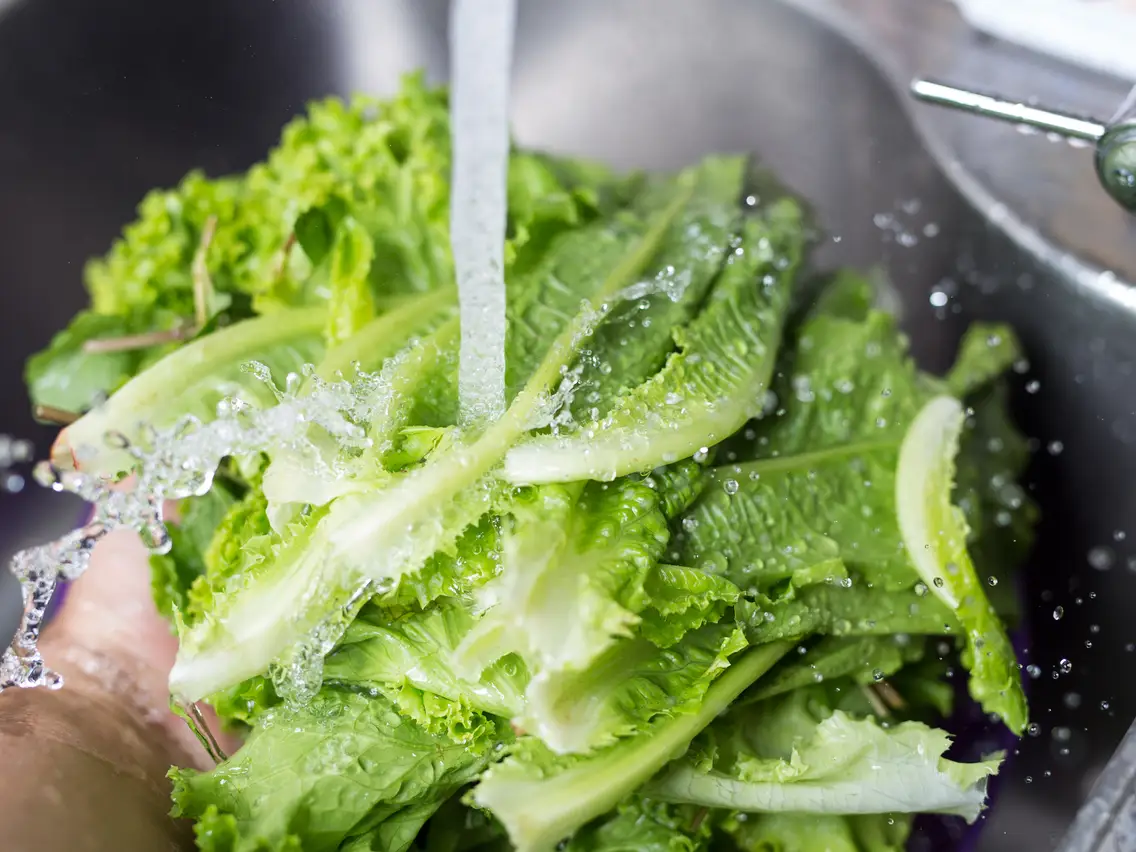Lettuce is a highly appreciated vegetable in the kitchen; it is usually served as a light appetizer or as a companion to many meals. It also provides important benefits to the body, since it fights anemia, prevents constipation, and helps control high cholesterol, regulates blood sugar levels, treats pain, and helps cure colds and many other benefits.
 However, lettuce can also cause us serious illnesses if we do not wash and disinfect it well, since it sometimes brings with it certain unhealthy microorganisms. How does this happen? If the lettuce is harvested at home or you buy it in a more natural way, it usually brings with it remains of soil and fertilizer that contain microorganisms. Also, if you have no guarantee of how it was grown, watered, and handled, you risk bacteria like Escherichia coli. Either way, you should always disinfect lettuce properly (even if you buy it from the supermarket).
However, lettuce can also cause us serious illnesses if we do not wash and disinfect it well, since it sometimes brings with it certain unhealthy microorganisms. How does this happen? If the lettuce is harvested at home or you buy it in a more natural way, it usually brings with it remains of soil and fertilizer that contain microorganisms. Also, if you have no guarantee of how it was grown, watered, and handled, you risk bacteria like Escherichia coli. Either way, you should always disinfect lettuce properly (even if you buy it from the supermarket).
How to disinfect lettuce without chemicals?
To disinfect the lettuce without any type of chemical, the general recommendations that you must follow are the following:
- The lettuce is cleaned just before consumption. Never wash this vegetable to store it, as excess moisture accelerates its deterioration.
- Wash your hands very well. Clean them carefully, using soap and water for 20 seconds.
- Thoroughly clean the work surface and the utensils that you will use. For example, knife, board, colander, the table, etc. Also, have a table for everything: one for vegetables, one for meats and one for fish. With all these measures, you avoid cross contamination.
- Strip the lettuce, wash and disinfect. Take the leaves out very carefully to avoid breaking or mistreating them. Submerge them in water with some natural antiseptic, such as lemon or vinegar, as we will explain below.
- The soaking time should not exceed 15-20 minutes. After that time, he rubs the lettuce leaves with his hands, one by one, very gently so as not to mistreat them. Does this until you feel no trace of dirt or any dirt?
- Rinse them under running water. Once the lettuce leaves are disinfected, rinse them very well, letting enough water run over them.
- Remove dark or wilted leaves.
- Dry the lettuce leaves very well before serving. Pass them through a strainer or dry them with kitchen paper. Afterwards, you can dress them and serve them as you prefer.
Tip: You should always wash the lettuce before cutting it.
How to disinfect lettuce with bleach?
One of the most efficient germicides for human food products is known as food-grade bleach. Be careful, it is not the bleach used for household cleaning tasks, since it is highly toxic and should never be used to disinfect food.
Bleach for food use helps purify drinking water and food (fruits and vegetables). The cleaning and disinfecting capacity of chlorine, in all its presentations, is indisputable, since it inhibits and destroys a wide variety of microorganisms: bacteria, viruses, molds, yeasts, spores, algae, protozoa, all microorganisms of faucal origin and many others. So what is the formula for washing lettuce with bleach?
- Pour a solution of 1 liter of water per 1 tsp. of food bleach into a large bowl.
- Follow the steps mentioned above, so that you submerge the lettuce in this solution and leave it for 20 minutes.
How to disinfect lettuce with vinegar?
White vinegar has well-known antimicrobial capabilities, which serve both to sanitize surfaces and remove grease and to disinfect vegetables. In addition, it is not toxic and is an excellent way to disinfect lettuce without chemicals. Most of its antiseptic action comes from its acid pH of 2.4 and its acetic content. However, you must consider that its effectiveness is around 80%, since there are pathogens that it cannot eliminate or inhibit. To use vinegar as a food disinfectant, do it as follows:
- Prepare a large container with water and vinegar. Do it in equal parts, that is, half and half (for example 250 ml of each).
- Always keep in mind to follow the disinfection protocol to guarantee the final result.
How to disinfect lettuce with baking soda?
Bicarbonate is a water-soluble compound that has a slightly alkaline taste. When this product is exposed to a somewhat strong acid, it breaks down into carbon dioxide and water. From this reaction, its multiple uses arise, among which its antimicrobial power stands out. Baking soda is excellent for disinfecting lettuce naturally, since it is not toxic and does not leave a taste. That said; prepare this antiseptic in the following way:
- Pour 1 liter of warm-hot water and a couple of teaspoons of baking soda into a large bowl.
- Use this homemade product always accompanied by the complete procedure to disinfect lettuce.
How to disinfect lettuce with lemon?
Lemon is a good natural antiseptic due to its high level of acidity that changes the pH in bacterial cells. Thus, an acidic environment develops in which microbes cannot survive. Its effectiveness as a disinfectant is said to surpass vinegar. How about we see the recipe for this natural disinfectant?
- Wash the lemons very well, rubbing the peel with a brush, rinse them with plenty of tap water and disinfect them.
- Put 1 liter of water and ¼ or ½ liter of lemon juice in a large bowl.
- Apply the steps to disinfect lettuce.
How to disinfect lettuce with hydrogen peroxide?
Hydrogen peroxide or hydrogen peroxide has germicidal properties, capable of eliminating microorganisms by oxidation, since it generates a controlled burning process. Perhaps many people would not associate this antiseptic with a food disinfectant, but it does work, since it is not toxic and eliminates many microorganisms. But how do you disinfect lettuce with hydrogen peroxide?
- Deposit 1 liter of water with ½ cup of hydrogen peroxide (10 volumes, for medical use) in a large bowl.
- Follow the method for sanitizing lettuce.
Although this way of disinfecting lettuce is not harmful, we recommend opting for the previous remedies, which are much safer. Once the lettuce has been disinfected, you can now use it to make your favorite recipes.



